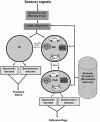The neurobiological bases for development of pharmacological treatments of aggressive disorders
- PMID: 18615178
- PMCID: PMC2435345
- DOI: 10.2174/157015907780866929
The neurobiological bases for development of pharmacological treatments of aggressive disorders
Abstract
Violence and aggression are major causes of death and injury, thus constituting primary public health problems throughout much of the world costing billions of dollars to society. The present review relates our understanding of the neurobiology of aggression and rage to pharmacological treatment strategies that have been utilized and those which may be applied in the future. Knowledge of the neural mechanisms governing aggression and rage is derived from studies in cat and rodents. The primary brain structures involved in the expression of rage behavior include the hypothalamus and midbrain periaqueductal gray. Limbic structures, which include amygdala, hippocampal formation, septal area, prefrontal cortex and anterior cingulate gyrus serve important modulating functions. Excitatory neurotransmitters that potentiate rage behavior include excitatory amino acids, substance P, catecholamines, cholecystokinin, vasopressin, and serotonin that act through 5-HT(2) receptors. Inhibitory neurotransmitters include GABA, enkephalins, and serotonin that act through 5-HT(1) receptors. Recent studies have demonstrated that brain cytokines, including IL-1beta and IL-2, powerfully modulate rage behavior. IL-1-beta exerts its actions by acting through 5-HT(2) receptors, while IL-2 acts through GABAA or NK(1) receptors. Pharmacological treatment strategies utilized for control of violent behavior have met with varying degrees of success. The most common approach has been to apply serotonergic compounds. Others included the application of antipsychotic, GABAergic (anti-epileptic) and dopaminergic drugs. Present and futures studies on the neurobiology of aggression may provide the basis for new and novel treatment strategies for the control of aggression and violence as well as the continuation of existing pharmacological approaches.
Keywords: Aggressive behavior; GABA; cytokines; defensive rage; enkephalins; impulsive behavior; predatory attack; serotonin.
Figures




Similar articles
-
Brain structures and neurotransmitters regulating aggression in cats: implications for human aggression.Prog Neuropsychopharmacol Biol Psychiatry. 2001 Jan;25(1):91-140. doi: 10.1016/s0278-5846(00)00150-0. Prog Neuropsychopharmacol Biol Psychiatry. 2001. PMID: 11263761 Review.
-
Neuroanatomical and neurochemical mechanisms underlying amygdaloid control of defensive rage behavior in the cat.Braz J Med Biol Res. 1994 Dec;27(12):2759-79. Braz J Med Biol Res. 1994. PMID: 7549999 Review.
-
Cytokine modulation of defensive rage behavior in the cat: role of GABAA and interleukin-2 receptors in the medial hypothalamus.Neuroscience. 2005;133(1):17-28. doi: 10.1016/j.neuroscience.2005.01.065. Neuroscience. 2005. PMID: 15893628
-
The neurobiology of aggression and rage: role of cytokines.Brain Behav Immun. 2006 Nov;20(6):507-14. doi: 10.1016/j.bbi.2006.05.002. Epub 2006 Aug 30. Brain Behav Immun. 2006. PMID: 16938427 Review.
-
Neurotransmitters regulating defensive rage behavior in the cat.Neurosci Biobehav Rev. 1997 Nov;21(6):733-42. doi: 10.1016/s0149-7634(96)00056-5. Neurosci Biobehav Rev. 1997. PMID: 9415898 Review.
Cited by
-
Abnormal white matter integrity in rapists as indicated by diffusion tensor imaging.BMC Neurosci. 2016 Jul 7;17(1):45. doi: 10.1186/s12868-016-0278-3. BMC Neurosci. 2016. PMID: 27388479 Free PMC article.
-
Can dietary intervention help in management of problem behaviors in dementia?J Nutr Health Aging. 2009 Jun;13(6):499-501. doi: 10.1007/s12603-009-0100-3. J Nutr Health Aging. 2009. PMID: 19536418 No abstract available.
-
Differential DNA methylation regions in cytokine and transcription factor genomic loci associate with childhood physical aggression.PLoS One. 2013 Aug 19;8(8):e71691. doi: 10.1371/journal.pone.0071691. eCollection 2013. PLoS One. 2013. PMID: 23977113 Free PMC article.
-
Candidate SNP markers of aggressiveness-related complications and comorbidities of genetic diseases are predicted by a significant change in the affinity of TATA-binding protein for human gene promoters.BMC Genomics. 2016 Dec 28;17(Suppl 14):995. doi: 10.1186/s12864-016-3353-3. BMC Genomics. 2016. PMID: 28105927 Free PMC article.
-
[Neurobiological and psychosocial causes of individual male violence].Nervenarzt. 2013 Nov;84(11):1329-44. doi: 10.1007/s00115-012-3610-x. Nervenarzt. 2013. PMID: 22911318 Review. German.
References
-
- Bellino S, Paradiso E, Bogetto F. Efficacy and tolerability of quetiapine in the treatment of borderline personality disorder. J Clin Psychiatry. 2006;67:1042–1046. - PubMed
-
- Bellus SB, Stewart D, Vergo JG, Kost PP, Grace J, Barkstrom SR. The use of lithium in the treatment of aggressive behaviours with two brain-injured individuals in a state psychiatric hospital. Brain Inj. 1996;10:849–860. - PubMed
-
- Bhatt S, Siegel A. Potentiating role of interleukin 2 (IL-2) receptors in the midbrain periaqueductal gray (PAG) upon defensive rage behavior in the cat: Role of neurokinin NK1 receptors. Behav Brain Res. 2006;167:251–260. - PubMed
-
- Bhatt S, Zalcman S, Hassanain M, Siegel A. Cytokine modulation of defensive rage behavior in the cat: Role of GABA(A) and interleukin2 receptors in the medial hypothalamus. Neuroscience. 2005;133:17–28. - PubMed
-
- Birger M, Swartz M, Cohen D, Alesh Y, Grishpan C, Kotelr M. Aggression: the testosterone-serotonin link. Isr Med Assoc J. 2003;5:653–658. - PubMed
Grants and funding
LinkOut - more resources
Full Text Sources
Miscellaneous
